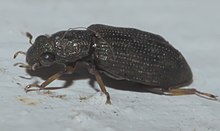Hydrochus
| Hydrochus | |
|---|---|

| |
| Scientific classification | |
| Kingdom: | Animalia |
| Phylum: | Arthropoda |
| Class: | Insecta |
| Order: | Coleoptera |
| Infraorder: | Staphyliniformia |
| Superfamily: | Hydrophiloidea |
| Family: | Hydrochidae Thomson, 1859 |
| Genus: | Hydrochus Leach, 1817 |
| Synonyms | |
|
Kiransus Makhan, 1994 | |
Hydrochus is a genus of water scavenger beetles in the monogeneric family Hydrochidae, sometimes placed in the Hydrophilidae as a subfamily Hydrochinae. The family Hydrochidae includes about 180 species, all of which are placed in the genus Hydrochus. Hydrochus has also been used for a fly genus in the family Dolichopodidae. This junior homonym is a junior subjective synonym of the genus Rhaphium.
Beetles in the genus Hydrochus are found in slow moving streams or stagnant water bodies. The club of the 7 segmented antenna consists of three segments with a cup-like basal segment. The number of tarsi on the legs are usually 5-5-5 or 4-4-4 (a tiny basal segment can be hard to see). The pronotum narrows towards the rear but is narrower than the base of the elytra. They walk around inside water or swim weakly in search of invertebrate prey. They hold air under the elytra. The larvae are also aquatic and predatory. An African species was formerly described under the genus Kiransus, but along with several other African species, they are now placed in Hydrochus.[1] Hydrochids are considered to be an older branch of the Hydrophiloidea. Hydrochids have been suggested as a sister group of the Spercheidae+Hydrophilidae but the relationships are unclear. Molecular phylogenetic comparisons suggest that they are related as a sister group to Helophorus+Georissus.[2]
An extinct member of the family, is known from the Early Cretaceous (Hauterivian) Khasurty locality in Russia.[3]


Species[]
More than 180 species have been described in the genus. The following list includes some of the species in the genus:[4]
- Castro & Delgado, 1999 g
- Valladares, 1988 g
- Germar, 1824 g
- Perkins, 2019
- (Makhan, 1994)
- Perkins, 2019
- Perkins, 2019
- Perkins, 2019
- (Herbst, 1793) g
- Knisch, 1922 i c g
- Makhan, 2005 i c g
- LeConte, 1855 i c g
- Perkins, 2019
- Perkins, 2019
- Perkins, 2019
- (Fabricius, 1792) g
- Hydrochus currani Brown, 1929 i c g b
- Sharp, 1882 i c g
- Perkins, 2019
- Knisch, 1921 g
- (Schaller, 1783) g
- Hansen, 1998
- Hydrochus excavatus LeConte, 1855 i c g b
- Hellman in Worthington, Hellman, and Lago 2016[5]
- g
- Küster, 1852 g
- Perkins, 2019
- Haldeman, 1852 i c g
- Kiesenwetter, 1870 g
- Hydrochus granulatus Blatchley, 1910 i c g b
- Perkins, 2019
- Valladares, Diaz & Delgado, 1999 g
- Motschulsky, 1860 g
- LeConte, 1855[5]
- Makhan, 1995 i c g
- Sharp, 1873 g
- Makhan, 1996 i c g
- Perkins, 2019
- Motschulsky, 1860 g
- Makhan, 1996
- Perkins, 2019
- Perkins, 2019
- Perkins, 2019
- van Berge Henegouwen, 1988 g
- Blatchley, 1919 i c g
- Smetana, 1988 i c g
- Hansen, 1998
- Sharp, 1903
- Mulsant, 1844 g
- Reitter, 1897
- Berge Henegouwen & Sainz-Cantero, 1992 g
- Sharp, 1882 i c g
- Hochhuth, 1871 g
- Makhan, 2000 i c g
- Chevrolat, 1863 i c g
- Perkins, 2019
- Oliva, 1996
- Hydrochus pseudosquamifer Miller, 1965 i c g b
- Orchymont, 1939 g
- Makhan, 1992
- Makhan, 2001 i c g
- Makhan, 1994
- Hydrochus rufipes Melsheimer, 1844 i c g b
- Hydrochus rugosus Mulsant, 1844 i c g b
- Perkins, 2019
- Hydrochus scabratus Mulsant, 1844 i c g b
- Makhan, 1995 i c g
- Leech, 1948 i c g
- Perkins, 2019
- Hydrochus simplex Leconte, 1851 i c g b
- Makhan 1992
- Fairmaire, 1879 g
- Hellman in Steiner, Staines, McCann and Hellman, 2003 i c g
- Hydrochus squamifer LeConte, 1855 i c g b
- Hydrochus subcupreus Randall, 1838 i c g b
- Ribera, Hernando & Aguilera, 1999 g
- Chevrolat, 1863 i c g
- LeConte, 1852 i c g
- Hansen, 1998
- Perkins, 2019
- LeConte, 1851 i c g
- Makhan, 2000 i c g
Data sources: i = ITIS,[6] c = Catalogue of Life,[7] g = GBIF,[8] b = Bugguide.net[9]
References[]
- ^ Hansen, M. (1998). "The systematic status of Kiransus Makhan, 1994, with the description of three new species of Hydrochus Leach, 1817 (Coleoptera: Hydrochidae)". Insect Systematics & Evolution. 29 (2): 223–232. doi:10.1163/187631298x00302.
- ^ Short, Andrew Edward Z.; Fikáček, Martin (2013). "Molecular phylogeny, evolution and classification of the Hydrophilidae (Coleoptera): Classification of the Hydrophilidae". Systematic Entomology. 38 (4): 723–752. doi:10.1111/syen.12024.
- ^ Prokin, A. A.; Strelnikova, O. D. (2021). "The first remarkable fossil Hydrochidae (Coleoptera) from the Lower Cretaceous (Hauterivian) of the Buryatia Republic, Russia". Cretaceous Research. 123: 104795. doi:10.1016/j.cretres.2021.104795. ISSN 0195-6671.
- ^ Hidalgo-Galiana, A.; Ribera, I. (2011). "Late Miocene diversification of the genus Hydrochus (Coleoptera, Hydrochidae) in the west Mediterranean area". Molecular Phylogenetics and Evolution. 59 (2): 377–385. doi:10.1016/j.ympev.2011.01.018. PMID 21354316.
- ^ a b Worthington, Reese J.; Hellman, John L.; Lago, Paul K. (2016). "Hydrochidae (Coleoptera) of Mississippi". Transactions of the American Entomological Society. 142 (2): 167–213. doi:10.3157/061.142.0206. S2CID 88919765.
- ^ "Hydrochus Report". Integrated Taxonomic Information System. Retrieved 2018-04-22.
- ^ "Browse Hydrochus". Catalogue of Life. Retrieved 2018-04-22.
- ^ "Hydrochus". GBIF. Retrieved 2018-04-22.
- ^ "Hydrochus Genus Information". BugGuide.net. Retrieved 2018-04-22.
- Hydrophiloidea
- Staphyliniformia genera
- Polyphaga stubs